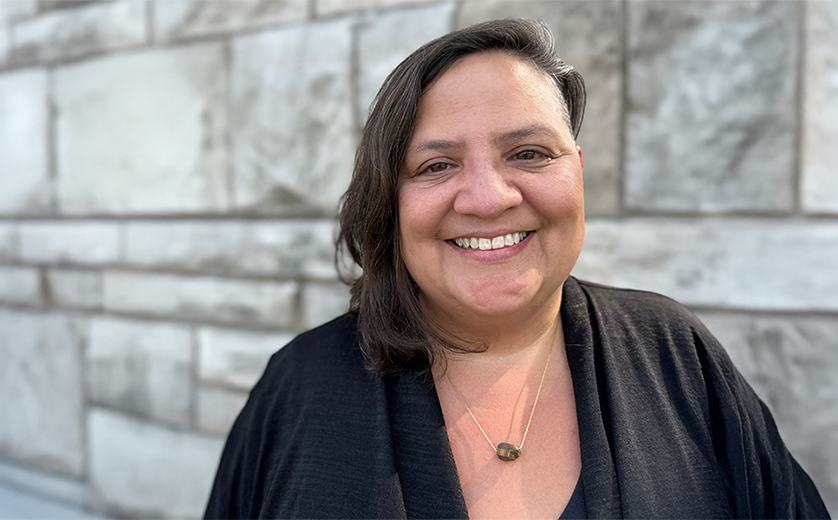Paz Galupo, the Audre Lorde Distinguished Professor for Sexual Health & Education at the Brown School at Washington University in St. Louis, has developed a new framework and measurement tool to better understand gender dysphoria.
To develop the Multidimensional Model of Gender Dysphoria and its accompanying assessment tool, Galupo, director of the Brown School’s Sexuality, Health, and Gender (SHAG) Center, collaborated with Louis Lindley, a doctoral candidate at the University of Wisconsin–Madison, and Zakary A. Clements, assistant professor of counseling psychology at Loyola University in Chicago and former postdoctoral researcher at the SHAG Center. The research, supported by a grant awarded to Galupo from the National Institute of Mental Health (NIMH), was published in the American Psychologist, the flagship journal of the American Psychological Association.
Gender dysphoria refers to the distress that may arise when a person feels that their gender does not coincide with their sex assigned at birth. It is the primary diagnosis that enables transgender and nonbinary (TNB) people to access gender-affirming care.
“At a time when evidenced-based gender-affirming care is being restricted legislatively, when trans and nonbinary identities are politicized, and when trans research is being unfairly targeted for termination at the federal level, this research provides a critical reframe for understanding the broader context of gender dysphoria,” Galupo said.
The new Multidimensional Model of Gender Dysphoria moves beyond traditional clinical perspectives by conceptualizing gender dysphoria as not merely as an individual trait but as an experienced shaped by social, relational, and cultural contests. The framework is the culmination of more than eight years of research and 12 publications by Galupo’s research group.
“The motivation behind this work was to hear directly from trans and nonbinary individuals about their experiences of gender dysphoria and have those experiences reflected in scientific theories and clinical models,” Galupo said. “As a trans health researcher, I am committed to research that reflects community experiences, and not just clinicians’ impressions of what trans people experience. Our model was developed based on research that prioritizes the perspectives of trans people.”
Clements said earlier research often failed to accurately reflect the realities of TNB individuals. The TNB experiences often did not resemble the clinical definitions and assessment tools that mental health professionals and researchers used to diagnose or measure gender dysphoria.
“Participants viewed traditional measures as outdated, not accounting for their identities or the fluctuations in gender dysphoria across different situations,” Clements said. “We used their critique to inform the way we developed our measure.”
Unlike existing clinical tools, which often focus narrowly on physical distress, the new Multidimensional Gender Dysphoria Measure (MGDM) provides a more holistic understanding of how TNB individuals experience gender dysphoria, highlighting the interplay between bodily distress, social invalidation, and societal stigma. The tool allows researchers and clinicians to examine how both psychological and medical interventions can work together to reduce gender dysphoria.
Importantly, the MGDM also accounts for changes over time, recognizing that gender dysphoria is not a static experience. It can vary across contexts, relationships, and stages of gender affirmation. By capturing these contextual and temporal changes, the MGDM offers a more nuanced understanding of how interventions such as psychosocial support could impact the mechanisms underlying gender dysphoria and its alleviation.
Lindley said the model’s inclusion of individual, social, and cultural factors opens new possibilities for intervention.
“As a field, we have been focused on interventions that help TNB people manage their gender dysphoria at an individual level, namely medical interventions,” Lindley said. “Our model highlights that gender dysphoria is not a purely individual experience, which opens the door for envisioning new ways to reduce interpersonal and societal components. For example, group therapy interventions could allow group members to help each other challenge negative thoughts and question societal messages regarding how TNB people should experience gender dysphoria.”
Galupo said the framework underscores the need for new interventions that address social and cultural systems that uphold anti-TNB rhetoric, erase TNB existence, and contribute to the way TNB people experience gender dysphoria.
“Especially now, as trans and nonbinary people face increased legislative attacks and large-scale social marginalization, our model highlights the need to challenge the societal forces that exacerbate gender dysphoria and threaten TNB well-being,” Galupo said.
